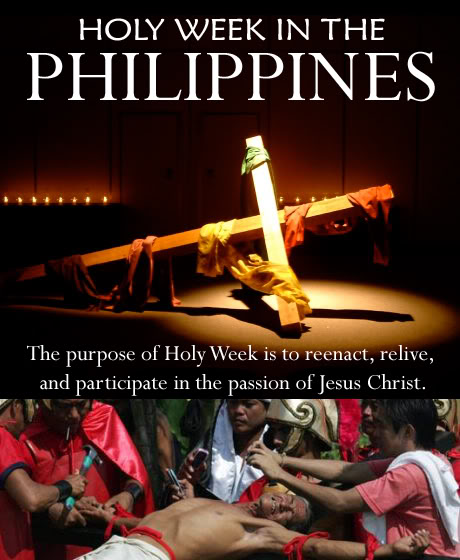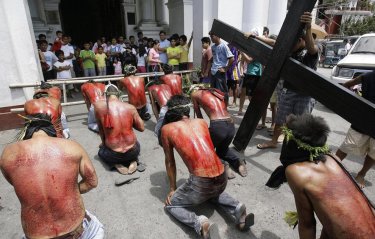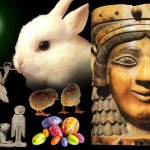[First posted 2012, when Sinai 6000 started this website. A timely article which gives a glimpse of the religious traditions of the country where the core community of Sinaites are based. This was contributed by Sinaite DVE@S6K/Admin2..–Admin1.]
It’s the time of the year again when most Filipinos are gearing up for another vacation trek to beaches, to Baguio, to Palawan, to Boracay, Subic, and other popular vacation spots and resorts all over the Philippines.
Juxtaposed with this time is the LENTEN SEASON or HOLY WEEK of this mostly Catholic-devotees nation. There are quaint customs that are practiced in this country, foremost of which is abstention from eating meat and fasting during this season. Even fast-foodchains jump into the bandwagon by offering non-meat options in their menu. Then there is the “Visita Iglesia” [church visit] done every Maundy Thursday where it is a custom to visit at least seven different churches on this day. Even Filipino families have traditional Good Friday fare that is served, the most popular being “Bacalao”, a dish prepared with dried cod fish.
Then there is the flogging and carrying and dragging of wooden crosses by penitents and even literal crucifixion on crosses. These events have been extensively covered by National Geographic in a documentary. Then on Easter Sunday, at dawn, there is the “Salubong” [meeting, welcoming] tradition where the “Virgin” Mother meets the Risen Christ.
These are my memories of “Holy Week”; as I matured in my spiritual walk, I understood that these practices are not even mentioned in the Tanakh, and all of them have pagan origins.
Ask most Catholics, and even Christians, how these practices and traditions came about and you will surely get a blank stare or a shrug. The following paragraphs will de-mystify these traditions and allow us to understand more fully that trusting the one, TRUE GOD, YHWH, is so simple and straight-forward:
Isaiah 56:13-17:
Bring no more vain oblations; it is an offering of abomination to me; new moon and Sabbath, the holding of convocations-I cannot endure iniquity along with the solemn assembly. Your new moons and your appointed seasons My soul hates; they are a burden to Me, I am weary to bear them, and when you spread forth your hands, I will hide My eyes from you, yes, when you make many prayers, I will not hear; your hands are full of blood. Wash and make yourself clean, put away your evil doings before My eyes, cease to do evil, Learn to do well; seek justice, relieve the oppressed, judge the fatherless, plead for the widow.
EASTER/EASTER EGGS
The word “Easter” is culled from Eastre, the Anglo-Saxon/Teutonic goddess of spring and fertility. A festival was held in her honor every year at the vernal equinox. Easter Sunday is set on the first Sunday after the full moon after the vernal Equinox on March 21. On Easter Sunday, it is typical to hunt for eggs, and
rabbits are symbols that mark the day. Why is this done? The Easter Bunny is a rabbit-spirit. Long ago, he was called the “Easter Hare”, hares and rabbits have frequent multiple births so they became a symbol of fertility. The custom of an Easter egg hunt began because children believed that hares laid eggs in the grass. The Romans believed that “All life comes from an egg.” Christians consider eggs to be “the seed of life” and so they are symbolic of the resurrection of Jesus Christ. In one way or another all the customs are a “salute to spring” marking re-birth. (Source: Mary Bellis, About.com Guide)
Another view on these practices during Holy Week traces them back to pagan celebrations and beliefs. “Ishtar”, which is pronounced “Easter” was a day that commemorated the resurrection of one of their gods that they called “Tammuz”, who was believed to be the only begotten son of the moon-goddess (Semiramis/Ishtar), and the sun-god (Nimrod/Baal). When Semiramis/Ishtar became queen due to the death of her son Tammuz, she proclaimed a forty day period of time of sorrow each year prior to the anniversary of the death of Tammuz. During this time, no meat was to be eaten. Worshippers were to meditate upon the sacred mysteries of Baal and Tammuz, and to make the sign of the “T” in front of their hearts as they worshipped. They also ate sacred cakes with the marking of a “T” or cross on the top. Every year, on the first Sunday after the first full moon after the spring equinox, a celebration was made. It was Ishtar’s Sunday and was celebrated with rabbits and eggs. Ishtar also proclaimed that because Tammuz was killed by a pig, that a pig must be eaten on that Sunday. (Source: David J. Meyer, Last Trumpet Ministries)
From these sources,
we can clearly see
that these practices
are not in any way
connected
to worshipping
the ONE, TRUE GOD,
YHWH.
Holy Week? Really?
DVE@S6K






